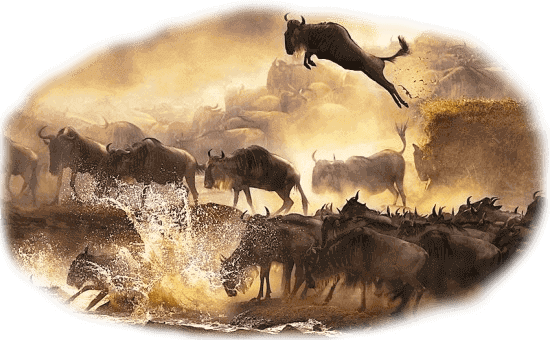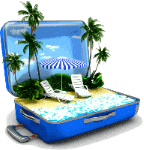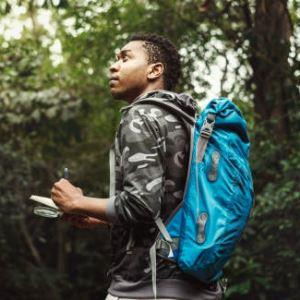 Kenya is an ideal destination for German tourists in search of adventure, culture, and natural beauty. With its diverse landscapes, vibrant traditions, and welcoming people, Kenya offers an unforgettable travel experience. From world-famous safari parks teeming with wildlife to ancient coastal towns rich in history, the country promises something unique for every kind of traveler. One of the top attractions for German visitors is the Maasai Mara National Reserve. Known for its expansive savannahs and high density of wildlife, the Mara is especially popular during the Great Migration. Visitors can witness thousands of wildebeest and zebras crossing the plains, often pursued by predators such as lions and crocodiles. Staying in luxury tented camps and engaging in guided safaris, tourists not only see the Big Five but also gain insights into the traditional Maasai culture. Nairobi, the capital city, is a dynamic mix of urban life and wildlife. A short drive from the city center leads to Nairobi National Park, where visitors can spot lions, giraffes, and rhinos with the skyline in the background. Cultural enthusiasts can explore the Nairobi National Museum, the Karen Blixen Museum, and the bustling Maasai Market. The city also offers a culinary journey through both local dishes and international cuisine, making it a flavorful stopover for German food lovers. Another gem is Lamu Island, a peaceful haven on the Kenyan coast. This UNESCO World Heritage Site is famous for its preserved Swahili architecture, ancient mosques, and car-free streets. German tourists often enjoy sailing on traditional dhows, sunbathing on quiet beaches, and participating in cultural events like the Lamu Cultural Festival. It is the perfect destination for those interested in history, art, and relaxation. For those looking to explore less-traveled paths, northern Kenya presents raw, untamed landscapes and deep cultural experiences. Lake Turkana, also called the Jade Sea, captivates visitors with its striking turquoise waters and surrounding desert. The Chalbi Desert, with its surreal terrain, offers camel safaris and interactions with nomadic tribes. The region is also a window into the lifestyles of communities like the Samburu and Rendille. Whether seeking luxury, adventure, or cultural depth, Kenya is full of remarkable destinations. For those planning a wildlife experience, the best safari parks in Kenya for German tourists include the Maasai Mara, Amboseli, and Tsavo, each with its own distinct allure. With careful planning, German travelers can create a journey filled with awe, discovery, and lasting memories.
Kenya is an ideal destination for German tourists in search of adventure, culture, and natural beauty. With its diverse landscapes, vibrant traditions, and welcoming people, Kenya offers an unforgettable travel experience. From world-famous safari parks teeming with wildlife to ancient coastal towns rich in history, the country promises something unique for every kind of traveler. One of the top attractions for German visitors is the Maasai Mara National Reserve. Known for its expansive savannahs and high density of wildlife, the Mara is especially popular during the Great Migration. Visitors can witness thousands of wildebeest and zebras crossing the plains, often pursued by predators such as lions and crocodiles. Staying in luxury tented camps and engaging in guided safaris, tourists not only see the Big Five but also gain insights into the traditional Maasai culture. Nairobi, the capital city, is a dynamic mix of urban life and wildlife. A short drive from the city center leads to Nairobi National Park, where visitors can spot lions, giraffes, and rhinos with the skyline in the background. Cultural enthusiasts can explore the Nairobi National Museum, the Karen Blixen Museum, and the bustling Maasai Market. The city also offers a culinary journey through both local dishes and international cuisine, making it a flavorful stopover for German food lovers. Another gem is Lamu Island, a peaceful haven on the Kenyan coast. This UNESCO World Heritage Site is famous for its preserved Swahili architecture, ancient mosques, and car-free streets. German tourists often enjoy sailing on traditional dhows, sunbathing on quiet beaches, and participating in cultural events like the Lamu Cultural Festival. It is the perfect destination for those interested in history, art, and relaxation. For those looking to explore less-traveled paths, northern Kenya presents raw, untamed landscapes and deep cultural experiences. Lake Turkana, also called the Jade Sea, captivates visitors with its striking turquoise waters and surrounding desert. The Chalbi Desert, with its surreal terrain, offers camel safaris and interactions with nomadic tribes. The region is also a window into the lifestyles of communities like the Samburu and Rendille. Whether seeking luxury, adventure, or cultural depth, Kenya is full of remarkable destinations. For those planning a wildlife experience, the best safari parks in Kenya for German tourists include the Maasai Mara, Amboseli, and Tsavo, each with its own distinct allure. With careful planning, German travelers can create a journey filled with awe, discovery, and lasting memories.
Top Kenyan Travel Destinations for German Tourists at a Glance
| Destination | Key Attractions | Recommended For |
|---|---|---|
| Maasai Mara | Big Five, Great Migration, Maasai culture | Wildlife and culture lovers |
| Nairobi | Museums, cuisine, giraffes, national park | Urban explorers |
| Lamu Island | Swahili architecture, beaches, historical sites | Culture and relaxation |
| Northern Kenya | Lake Turkana, Chalbi Desert, tribal cultures | Adventurous explorers |
Explore the Magical Maasai Mara and Its Breathtaking Wildlife
The Maasai Mara is often considered the pinnacle of Kenya's wildlife tourism, particularly among German travelers eager for a thrilling safari adventure. Spanning over 1,500 square kilometers, this iconic reserve is known for its sweeping grasslands, acacia-dotted plains, and an incredible density of wildlife. It is one of the few places in the world where visitors can reliably see the Big Five lions, leopards, elephants, rhinos, and buffaloes in a single game drive. Each year between July and October, the Great Migration transforms the Mara into a stage of natural drama. Millions of wildebeest, zebras, and gazelles cross over from Tanzania's Serengeti in search of greener pastures, pursued by predators in a life-or-death struggle. For German tourists, this event is an awe-inspiring spectacle and a chance to witness one of nature's most impressive phenomena. Accommodations in the Maasai Mara range from luxurious tented lodges with panoramic views to eco-friendly camps that blend comfort with sustainability. Many of these lodges offer guided safaris led by expert local rangers, providing insight into animal behavior, conservation efforts, and the ecosystem. Cultural interactions with the Maasai people add an enriching dimension, offering tourists a deeper understanding of indigenous traditions and ways of life. Photographers and nature lovers will find endless inspiration in the Mara's vivid sunsets, roaming herds, and dramatic landscapes. For those planning a memorable African holiday, Kenya big five safari tours for Germans are an excellent way to combine top-tier wildlife experiences with cultural immersion and luxury travel. Whether it’s a honeymoon, a family trip, or a solo journey, the Maasai Mara delivers moments of awe and unforgettable close encounters with wildlife. Visitors can expect to be mesmerized by the majestic sight of lions lazing under acacia trees, elephants trudging gracefully through the savannah, and cheetahs sprinting across the plains in pursuit of prey. The Mara’s golden grasslands are alive with drama, making each safari drive an unpredictable and thrilling experience. Beyond the wildlife, the Maasai Mara is a place where nature and culture coexist harmoniously. Tourists often have the opportunity to visit local Maasai villages, where they can learn about age-old traditions, dances, and crafts passed down through generations. These cultural exchanges deepen the appreciation for the region and its people, creating memories that go beyond mere sightseeing. Luxury lodges and eco-camps offer a range of accommodations suited to different tastes and budgets, often with stunning views of the landscape and wildlife. At night, the African sky dazzles with constellations, offering yet another spectacle to end the day. With so much to offer, it’s no surprise that the Maasai Mara remains one of the most visually striking and rewarding safari destinations on the African continent.
Safari in Maasai Mara National Reserve with the Big Five
For German tourists dreaming of an authentic African adventure, the Maasai Mara National Reserve offers an unforgettable safari experience. This vast and iconic landscape, spanning over 1,500 square kilometers, is a haven for wildlife and one of the best places in Africa to see the famed Big Five: lions, leopards, elephants, buffaloes, and rhinos. The reserve also plays host to the Great Migration, a phenomenal event where millions of wildebeest, zebras, and gazelles move across the plains in search of greener pastures, creating dramatic encounters with predators. Visitors can choose from a variety of accommodations, ranging from luxurious tented camps to more budget-friendly eco-lodges, making it possible for travelers with different budgets to experience the magic of the Mara. These camps often offer all-inclusive packages that cover guided game drives, meals, and cultural visits to Maasai villages. Such immersive experiences give travelers a glimpse into the rich traditions of the local communities, adding cultural depth to their wildlife adventure. For travelers from Germany looking to balance quality and value, there are many affordable Kenya safari packages for German visitors. These packages ensure that guests enjoy top-tier wildlife viewing and comfort without compromising on their budget. They also often include domestic flights, park entry fees, and expert guides, allowing for a hassle-free, enriching safari journey. The Maasai Mara's picturesque scenery, abundant wildlife, and cultural significance make it an ideal destination for photographers, nature enthusiasts, and first-time safari-goers. Golden sunsets stretch across the savannah, casting a warm glow over acacia trees and wandering herds of elephants. The distant calls of lions echo in the twilight, immersing visitors in the untamed beauty of the African wilderness. Every safari outing feels like a scene from a nature documentary, filled with unexpected animal sightings and stunning landscapes. For those interested in capturing the essence of Africa on camera, the Mara offers a dream backdrop from dramatic predator-prey interactions to peaceful moments at watering holes. Birdwatchers will also be delighted by the reserve’s diverse avian species. Meanwhile, cultural excursions to nearby Maasai villages provide a meaningful connection to Kenya’s indigenous heritage, showcasing traditional dances, crafts, and community life. Whether you're drawn by wildlife, culture, or breathtaking scenery, the Maasai Mara offers a complete and profoundly enriching experience.
Discover Nairobi’s Culture, Cuisine, and Urban Wildlife Parks
 Nairobi, Kenya's bustling capital city, serves as an ideal gateway for German tourists looking to combine cultural discovery with wildlife adventure. Unlike many other capital cities, Nairobi offers a rare chance to observe wild animals just minutes from the city center. Nairobi National Park is home to lions, giraffes, zebras, and rhinos, all set against the backdrop of urban skyscrapers a unique juxtaposition that fascinates many first-time visitors. Beyond its wild side, Nairobi is a hub of vibrant culture and history. German tourists can begin their exploration at the Nairobi National Museum, which showcases Kenya’s diverse heritage, from prehistoric fossils to tribal artifacts. The Karen Blixen Museum offers a nostalgic glimpse into colonial-era Kenya and the life of the famed Danish author of "Out of Africa." Food enthusiasts will find the city’s culinary scene diverse and exciting. Nairobi's restaurants serve everything from traditional Kenyan dishes like nyama choma and ugali to contemporary fusion cuisine. Food markets and street vendors add to the experience, giving visitors a taste of everyday life in Kenya’s capital. One of the most rewarding cultural experiences in Kenya for German tourists is a visit to the bustling Maasai Market. Held at various locations throughout the week, this open-air market features handmade crafts, beadwork, textiles, and carvings. It’s not just a shopping destination but a vibrant meeting point of local creativity and tradition. The David Sheldrick Wildlife Trust and the Giraffe Centre allow tourists to connect with conservation efforts while engaging closely with rescued elephants and endangered Rothschild giraffes. These encounters are not only educational but emotionally resonant, especially for visitors interested in wildlife protection. Nairobi’s charm lies in its balance, offering both modern comforts and rich, immersive experiences that cater to a wide range of interests. The city seamlessly blends Kenya’s traditional heritage with contemporary culture, making it a fascinating stop for German travelers. Whether you're wandering through its world-class museums, enjoying the colors and crafts of open-air markets, or savoring a variety of local and international cuisines, Nairobi always delivers something new and exciting. The city is also an excellent place to engage with Kenya’s many ethnic cultures. Visitors can attend music performances, explore art galleries, or even take part in cooking classes that highlight the diversity of Kenyan cuisine. Local neighborhoods such as Westlands and Kilimani are hotspots for culture, nightlife, and shopping, offering an urban contrast to the wildlife experiences available at Nairobi National Park. German travelers will find Nairobi not only a gateway to Kenya’s wilderness but also a cultural and culinary destination in its own right full of opportunities to connect, learn, and explore.
Nairobi, Kenya's bustling capital city, serves as an ideal gateway for German tourists looking to combine cultural discovery with wildlife adventure. Unlike many other capital cities, Nairobi offers a rare chance to observe wild animals just minutes from the city center. Nairobi National Park is home to lions, giraffes, zebras, and rhinos, all set against the backdrop of urban skyscrapers a unique juxtaposition that fascinates many first-time visitors. Beyond its wild side, Nairobi is a hub of vibrant culture and history. German tourists can begin their exploration at the Nairobi National Museum, which showcases Kenya’s diverse heritage, from prehistoric fossils to tribal artifacts. The Karen Blixen Museum offers a nostalgic glimpse into colonial-era Kenya and the life of the famed Danish author of "Out of Africa." Food enthusiasts will find the city’s culinary scene diverse and exciting. Nairobi's restaurants serve everything from traditional Kenyan dishes like nyama choma and ugali to contemporary fusion cuisine. Food markets and street vendors add to the experience, giving visitors a taste of everyday life in Kenya’s capital. One of the most rewarding cultural experiences in Kenya for German tourists is a visit to the bustling Maasai Market. Held at various locations throughout the week, this open-air market features handmade crafts, beadwork, textiles, and carvings. It’s not just a shopping destination but a vibrant meeting point of local creativity and tradition. The David Sheldrick Wildlife Trust and the Giraffe Centre allow tourists to connect with conservation efforts while engaging closely with rescued elephants and endangered Rothschild giraffes. These encounters are not only educational but emotionally resonant, especially for visitors interested in wildlife protection. Nairobi’s charm lies in its balance, offering both modern comforts and rich, immersive experiences that cater to a wide range of interests. The city seamlessly blends Kenya’s traditional heritage with contemporary culture, making it a fascinating stop for German travelers. Whether you're wandering through its world-class museums, enjoying the colors and crafts of open-air markets, or savoring a variety of local and international cuisines, Nairobi always delivers something new and exciting. The city is also an excellent place to engage with Kenya’s many ethnic cultures. Visitors can attend music performances, explore art galleries, or even take part in cooking classes that highlight the diversity of Kenyan cuisine. Local neighborhoods such as Westlands and Kilimani are hotspots for culture, nightlife, and shopping, offering an urban contrast to the wildlife experiences available at Nairobi National Park. German travelers will find Nairobi not only a gateway to Kenya’s wilderness but also a cultural and culinary destination in its own right full of opportunities to connect, learn, and explore.
Things to Do in Nairobi: Museums, Markets, and Giraffes
Nairobi is a city of contrasts, where urban sophistication meets raw natural beauty. German tourists visiting Kenya’s capital will find no shortage of enriching activities that blend culture, history, wildlife, and cuisine. Below are some of the top things to do in Nairobi, each explained to help you make the most of your stay:
- Visit Nairobi National Park: Just a short drive from the city center, this park offers a chance to see lions, giraffes, rhinos, and more with the city skyline in the background a truly unique African experience.
- Explore the Nairobi National Museum: Dive into Kenya's natural, cultural, and political history. The museum features exhibits on early human fossils, traditional art, and regional ethnography, making it perfect for those seeking deeper context.
- Shop at the Maasai Market: This open-air market is held at various locations throughout the week. It's ideal for picking up souvenirs like beadwork, carvings, and textiles while interacting directly with local artisans.
- Tour the Karen Blixen Museum: Set in the former home of the "Out of Africa" author, the museum offers insight into colonial Kenya and the life of one of its most famous expatriates.
- Feed Giraffes at the Giraffe Centre: Get up close to endangered Rothschild giraffes, feed them from a viewing platform, and learn about conservation efforts in a fun and educational setting.
- Visit the David Sheldrick Wildlife Trust: Meet rescued baby elephants and learn about their rehabilitation. This experience is both heartwarming and informative, particularly for animal lovers.
- Try Local Cuisine: Nairobi has a vibrant food scene. Sample traditional Kenyan dishes like nyama choma (roast meat), sukuma wiki (collard greens), and chapati. Local restaurants and food markets offer both authentic and fusion culinary delights.
- Explore Art and Music Scenes: Check out local galleries such as the Nairobi Gallery or attend a live music performance at venues around Westlands or Kilimani for a taste of contemporary Kenyan culture.
With this mix of attractions, Nairobi serves not just as a stopover but as a destination in its own right. Whether you're interested in history, wildlife, shopping, or food, the city offers an immersive and memorable experience.
Wander Through Lamu’s Ancient Streets and Swahili Heritage
Lamu Island, nestled off the northern coast of Kenya, is a hidden gem steeped in centuries of Swahili history and culture. A UNESCO World Heritage Site, this ancient town offers German travelers a unique chance to explore one of the oldest continuously inhabited settlements in East Africa. With no cars on the island, the atmosphere remains serene and timeless. Transport is mainly by foot, donkey, or dhow boat, allowing visitors to immerse themselves in a slower, more traditional rhythm of life. Walking through Lamu’s narrow alleyways reveals beautifully preserved Swahili architecture, a blend of African, Arab, and Indian influences that dates back to the 14th century. Landmarks like the Lamu Fort and Riyadha Mosque provide cultural and historical context to the island’s rich past. The bustling town square is alive with vibrant local markets where artisans sell intricate beadwork, wood carvings, and woven baskets, all of which make authentic souvenirs. For those drawn to coastal beauty, Lamu’s pristine beaches offer tranquil retreats with turquoise waters and soft white sand. Tourists can take dhow sailing trips to nearby islands, snorkel in the coral reefs, or simply relax in the sun. The island also hosts cultural events like the Lamu Cultural Festival, showcasing traditional music, poetry, and dhow races that bring the Swahili heritage to life. Swahili coast culture trips for German travelers are especially rewarding on Lamu Island, where historical depth and authentic local interactions offer more than just scenic views. A visit here is not about rushing from one site to another but about soaking in the ambiance, understanding the layers of cultural influence, and engaging with a living heritage that continues to thrive. Whether exploring old mosques, learning Swahili cooking in a local home, or watching fishermen bring in their daily catch, German tourists will find that Lamu offers an enriching escape from the usual tourist path. The island’s peaceful charm invites slow, intentional exploration and deep engagement with its layered history. As dhows glide through the turquoise waters and call to prayer echoes from minarets, visitors are immersed in the rhythms of Swahili life. Local cooking classes, artisanal craft demonstrations, and storytelling events help bring centuries-old traditions into focus. These experiences go beyond surface-level tourism, allowing travelers to connect with the community in meaningful ways. It’s this authenticity that makes Lamu so memorable an island where time seems to pause and cultural preservation is not just a practice but a way of life. For German tourists, Lamu is more than a destination; it’s a doorway to understanding the soul of Kenya’s coastal heritage.
Lamu Island Travel Guide: Architecture, Beaches, and Culture
Lamu Island is a treasure for travelers who seek beauty, heritage, and authentic cultural encounters. Yet, it also serves as an excellent starting point for exploring the surrounding Swahili Coast a region rich in biodiversity and tradition. For German visitors who appreciate nature as much as history, the coast offers unforgettable opportunities to blend relaxation with eco-conscious exploration. From Lamu, travelers can take dhow trips to nearby islands like Manda and Pate, where coastal villages and untouched beaches welcome those looking to go beyond the typical tourist route. These journeys offer immersive views of Kenya's marine life, mangrove forests, and coral reefs. It's not uncommon to spot dolphins, sea turtles, and exotic fish species in the warm Indian Ocean waters. The surrounding coastal region is also a birdwatcher’s paradise. Mangroves, estuaries, and wetlands near Lamu are home to hundreds of bird species, making it an ideal location for birdwatching in Kenya for German ecotourists. Whether observing African fish eagles soaring above or spotting kingfishers along the shore, the area delivers on both beauty and biodiversity. Local guides, many of whom are conservation advocates, enhance the experience by sharing their knowledge of coastal ecosystems and cultural practices. These tours help travelers understand the delicate balance between development and preservation along Kenya's fragile coastline. German ecotourists will find that the Swahili coast is more than just a scenic destination; it is a living classroom of environmental harmony and cultural resilience. Whether it’s joining a community beach clean-up, learning traditional sailing methods, or simply enjoying the views from a dhow at sunset, the coastal journey from Lamu offers a deeply fulfilling and responsible travel experience.
Hidden Gems in Northern Kenya for the Curious German Explorer
 Northern Kenya remains one of the country's most unspoiled and adventurous regions, offering a raw and breathtaking experience for German travelers eager to venture off the beaten path. This vast area is marked by dramatic landscapes, rare wildlife, and deep-rooted cultural traditions that differ greatly from Kenya's more frequently visited southern safari circuits. Lake Turkana, often referred to as the Jade Sea due to its striking greenish-blue color, is one of the most iconic attractions in northern Kenya. It is the world’s largest desert lake and is surrounded by extinct volcanoes and lava fields that give the region a lunar appearance. The lake's remote location and stark beauty make it a perfect destination for travelers seeking solitude, photography opportunities, and a connection to prehistoric history, with nearby Koobi Fora being a rich fossil site. Another unique destination is the Chalbi Desert, a vast expanse of salt flats and dunes. Travelers can enjoy camel safaris across the shifting sands and experience nomadic life firsthand. Encounters with the Rendille and Gabbra people reveal traditional lifestyles that have remained largely unchanged for centuries. Visitors can learn about camel husbandry, beadwork, and desert survival techniques from these resilient communities. The Samburu region, further south in northern Kenya, offers striking scenery and access to Samburu National Reserve. Here, German tourists can see species unique to the north, such as the Grevy’s zebra, reticulated giraffe, and Somali ostrich. The Samburu people, known for their colorful attire and strong warrior traditions, welcome cultural interactions through village visits, traditional dances, and storytelling sessions around the fire. Road travel in northern Kenya requires preparation and a sense of adventure, as infrastructure can be limited. However, the rewards are immense: star-studded skies, unforgettable vistas, and an immersion into the heart of Kenya’s cultural and geographic diversity. For German tourists who value authenticity, discovery, and meaningful travel, northern Kenya offers one of the richest and least commercialized experiences in the country. Whether you're gazing across the alien landscapes of the Chalbi Desert or sharing tea with a Samburu elder, every moment in northern Kenya invites connection and reflection. It is a place where the stories of people and land are deeply intertwined, creating a journey that stays with you long after you've returned home.
Northern Kenya remains one of the country's most unspoiled and adventurous regions, offering a raw and breathtaking experience for German travelers eager to venture off the beaten path. This vast area is marked by dramatic landscapes, rare wildlife, and deep-rooted cultural traditions that differ greatly from Kenya's more frequently visited southern safari circuits. Lake Turkana, often referred to as the Jade Sea due to its striking greenish-blue color, is one of the most iconic attractions in northern Kenya. It is the world’s largest desert lake and is surrounded by extinct volcanoes and lava fields that give the region a lunar appearance. The lake's remote location and stark beauty make it a perfect destination for travelers seeking solitude, photography opportunities, and a connection to prehistoric history, with nearby Koobi Fora being a rich fossil site. Another unique destination is the Chalbi Desert, a vast expanse of salt flats and dunes. Travelers can enjoy camel safaris across the shifting sands and experience nomadic life firsthand. Encounters with the Rendille and Gabbra people reveal traditional lifestyles that have remained largely unchanged for centuries. Visitors can learn about camel husbandry, beadwork, and desert survival techniques from these resilient communities. The Samburu region, further south in northern Kenya, offers striking scenery and access to Samburu National Reserve. Here, German tourists can see species unique to the north, such as the Grevy’s zebra, reticulated giraffe, and Somali ostrich. The Samburu people, known for their colorful attire and strong warrior traditions, welcome cultural interactions through village visits, traditional dances, and storytelling sessions around the fire. Road travel in northern Kenya requires preparation and a sense of adventure, as infrastructure can be limited. However, the rewards are immense: star-studded skies, unforgettable vistas, and an immersion into the heart of Kenya’s cultural and geographic diversity. For German tourists who value authenticity, discovery, and meaningful travel, northern Kenya offers one of the richest and least commercialized experiences in the country. Whether you're gazing across the alien landscapes of the Chalbi Desert or sharing tea with a Samburu elder, every moment in northern Kenya invites connection and reflection. It is a place where the stories of people and land are deeply intertwined, creating a journey that stays with you long after you've returned home.
Northern Kenya Attractions: Lakes, Deserts, and Tribal Cultures
Northern Kenya offers an extraordinary range of natural and cultural attractions that are ideal for adventurous German travelers. The region is defined by its remote beauty, unique ecosystems, and a rich tapestry of tribal cultures that have thrived in this arid environment for centuries. One of the most captivating destinations in this region is Lake Turkana. Known as the Jade Sea for its shimmering green-blue waters, it is the world’s largest desert lake and a vital ecological and historical site. The surrounding landscape is surreal, dotted with volcanic outcrops and ancient archaeological sites such as Koobi Fora, where some of the earliest human fossils were discovered. The Chalbi Desert, located east of Turkana, is another remarkable feature. A vast expanse of salt flats, sand dunes, and occasional oases, it offers visitors the chance to embark on camel safaris or 4x4 excursions into a truly unspoiled wilderness. Cultural encounters with the nomadic Rendille and Gabbra tribes add depth to the journey, offering insights into their centuries-old ways of life that revolve around livestock, craft, and oral traditions. Farther south lies the Samburu region, home to the Samburu National Reserve and its uniquely adapted wildlife. Here, German tourists can see the Samburu Special Five the Grevy’s zebra, Somali ostrich, gerenuk, reticulated giraffe, and Beisa oryx in their natural habitat. The landscape is rugged yet beautiful, with the Ewaso Ng’iro River providing a lifeline to both animals and people. Visiting local Samburu villages allows tourists to experience vibrant traditions, including colorful beadwork, age-old ceremonies, and stories passed down through generations. Northern Kenya requires a spirit of adventure and some logistical planning, but the payoff is immense. The region offers a sense of isolation and authenticity that is increasingly rare in a globalized travel industry. Roads can be rough, and accommodations may be basic in some areas, but these challenges are part of what make the experience so rewarding. Whether you are hiking through volcanic craters, camping under a blanket of stars, or sharing a meal with a local family, northern Kenya leaves a lasting impression. This part of Kenya is not just a destination; it's a frontier where nature and tradition meet in their purest forms. For German tourists seeking something different an adventure that blends dramatic scenery, rare wildlife, and real cultural exchange northern Kenya stands as one of Africa’s most compelling and unspoiled regions.






